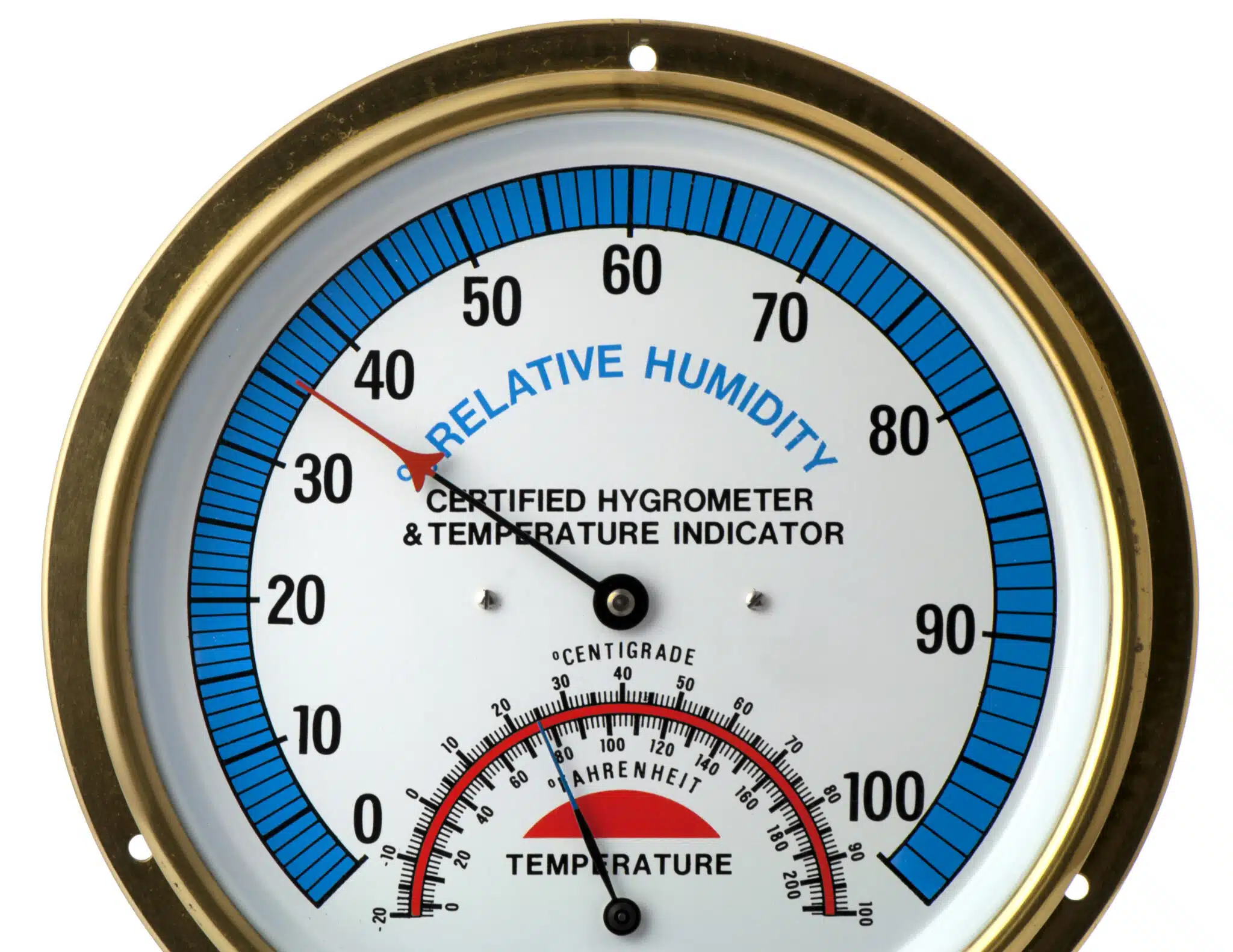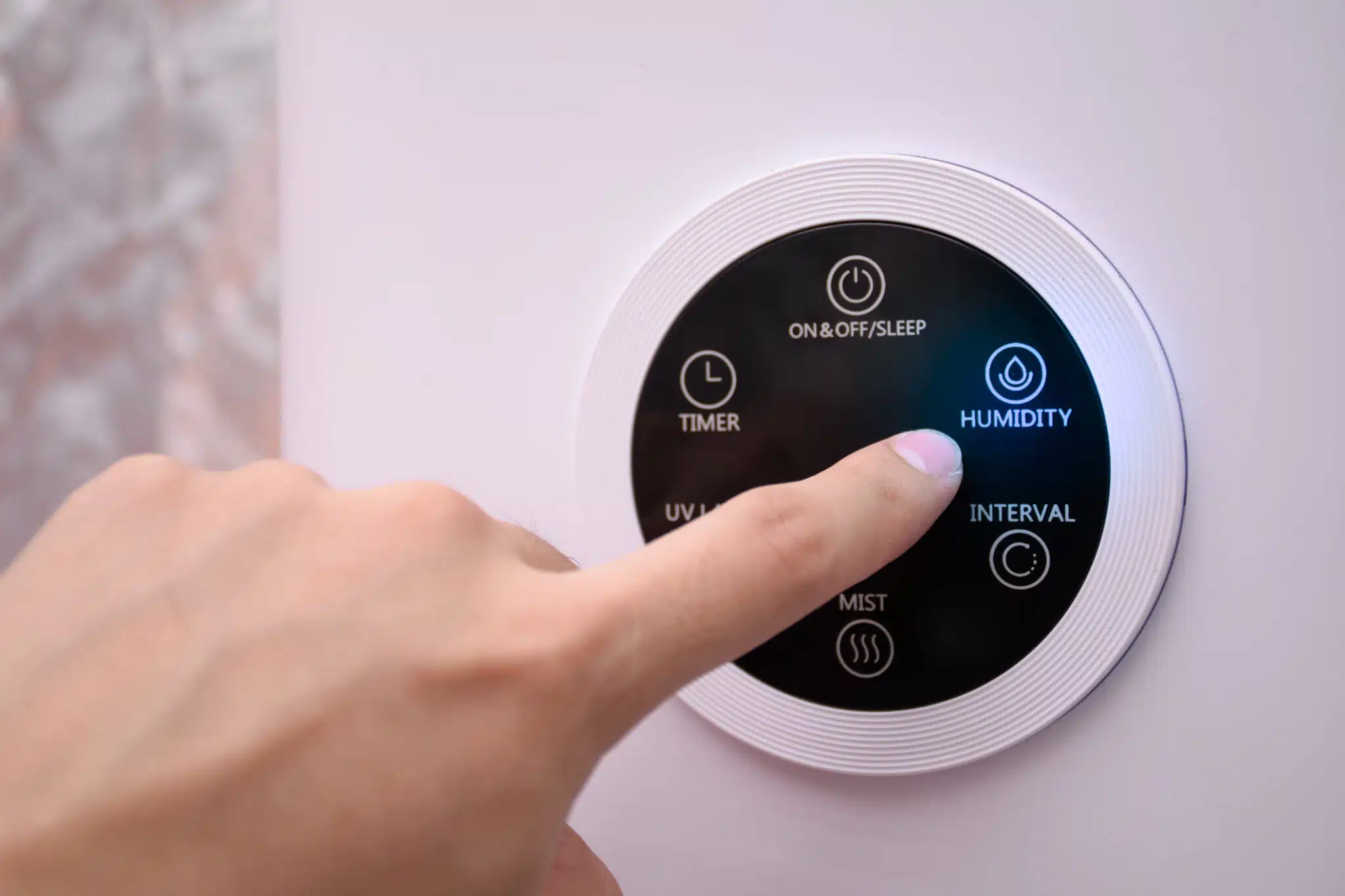Indoor Humidity – Maintaining the right humidity levels in your home is essential for comfort and health, especially during the fall season in Lancaster, PA. As temperatures drop and the air becomes drier, indoor humidity can fluctuate, leading to potential issues like dry skin, respiratory discomfort, and even damage to your home.
Understanding Indoor Humidity
What is Indoor Humidity?
Indoor humidity refers to the amount of water vapor present in the air inside your home. This vapor is an essential component of the air we breathe, influencing everything from comfort and health to the condition of your home’s materials.
Proper indoor humidity levels are crucial for maintaining a balanced environment. Typically measured as a percentage, 100% humidity means the air is fully saturated with moisture and cannot hold anymore.
During the fall, the goal is to maintain indoor humidity within a specific range that supports comfort, health, and the preservation of your home.
The Ideal Humidity Range for Fall
The recommended indoor humidity level during the fall typically falls between 30% and 50%. This range is considered ideal because it balances the need for comfort with the need to prevent issues such as mold growth, dust mite proliferation, and structural damage.
Lower humidity levels can lead to dry skin, respiratory discomfort, and damage to wooden furnishings, while higher levels can cause condensation, mold, and mildew.
As outdoor temperatures cool, indoor humidity levels can fluctuate, making it important to actively monitor and adjust your home’s humidity.
Signs of Imbalanced Indoor Humidity
Too Low Humidity
Low humidity is a common problem during the fall and winter months, particularly when heating systems are in constant use. If your indoor humidity drops below 30%, you’re likely to notice both discomfort and damage.
Health Effects: Dry air isn’t just uncomfortable—it can cause serious issues like skin irritation, dry throat, and respiratory problems. For those with asthma or allergies, low humidity can make symptoms significantly worse.
Home Damage: Beyond health concerns, low humidity can wreak havoc on your home. Wood floors, furniture, and musical instruments can shrink, crack, or warp. Even your walls aren’t safe, as low humidity can cause wallpaper to peel and paint to crack, diminishing your home’s beauty.
Too High Humidity
Although less common in the fall, high indoor humidity—levels above 50%—can still pose significant problems.
Health Risks: High humidity creates the perfect environment for mold and dust mites, which can trigger allergic reactions and respiratory issues. Mold exposure can lead to serious health problems if left unchecked.
Home Damage: Excess moisture doesn’t just harm your health; it can also damage your home. You may notice condensation on windows, mold growth, wood rot, and even structural damage. High humidity can also cause paint to bubble and peel, and wood to swell, leading to sticking doors and windows that no longer fit properly.
Balancing indoor humidity is not just about comfort—it’s essential for protecting your health and your home.

Practical Solutions for Maintaining Ideal Humidity
Using a Hygrometer
To effectively manage indoor humidity, it’s crucial to monitor it regularly with a hygrometer. This device provides real-time readings of your home’s humidity levels, allowing you to make informed decisions about when and how to adjust your indoor environment.
Types of Hygrometers
Hygrometers come in various forms, from simple analog models to advanced digital devices that can be integrated into smart home systems.
Digital hygrometers are often preferred for their accuracy and additional features, such as temperature readings and data logging, which can help you track changes in humidity over time.
Placement: Place your hygrometer in a central location, such as the living room or hallway, to get an accurate reading of your home’s overall humidity. If you have specific areas that are prone to humidity issues, such as bathrooms or basements, consider placing additional hygrometers in those locations to monitor localized conditions.
Adjusting Your HVAC System
Your HVAC system is a powerful tool for controlling indoor humidity. Whether you have a central HVAC system or rely on portable units, there are several strategies you can use to maintain optimal humidity levels throughout the fall.
Integrated Humidifiers and Dehumidifiers
Many modern HVAC systems come equipped with built-in humidifiers and dehumidifiers, allowing you to automatically regulate humidity levels. These systems can be programmed to maintain specific humidity levels based on the time of day, outside weather conditions, or your personal comfort preferences.
Manual Adjustments
If your HVAC system doesn’t include integrated humidity control, you can still manage humidity manually. Portable humidifiers can be used to add moisture to dry rooms, while portable dehumidifiers can reduce moisture in damp areas. It’s important to choose the right size unit for your space to ensure effective humidity control.
Regular Maintenance
Maintaining your HVAC system is essential for ensuring it functions properly and efficiently. Change filters regularly, clean ducts, and schedule professional inspections to prevent issues that could affect your home’s humidity levels. A well-maintained system will not only help you control humidity but also improve indoor air quality and energy efficiency.
Natural Ventilation and Humidifiers
Incorporating natural ventilation and using humidifiers strategically can help you maintain balanced indoor humidity during the fall.
Natural Ventilation: On mild fall days, opening windows and doors allows fresh air to circulate through your home, helping to balance indoor humidity. Ventilation is particularly important in areas where moisture tends to accumulate, such as bathrooms and kitchens. Use exhaust fans in these areas to remove excess moisture and prevent humidity buildup.
Portable Humidifiers: If your home tends to be dry, especially during colder fall days when the heating system is running, using portable humidifiers can help add moisture to the air. Choose humidifiers with adjustable settings to control the amount of moisture being added to the air and place them in rooms where you spend the most time, such as bedrooms and living rooms.
Maintenance: Regularly clean and maintain your humidifiers to prevent the growth of mold and bacteria. Use distilled water to reduce mineral buildup and follow the manufacturer’s instructions for cleaning and filter replacement. This will ensure your humidifiers continue to operate efficiently and safely.
Sealing Gaps and Cracks
Drafts and air leaks can significantly impact indoor humidity by allowing cold, dry air to enter your home and warm, moist air to escape. Addressing these issues is a simple but effective way to maintain a consistent indoor environment.
Identifying Leaks: To identify drafts, walk around your home on a windy day and feel the cold air coming in around windows, doors, and other openings. You can also use a candle or incense stick to detect air movement—if the flame or smoke wavers, there’s likely a draft.
Sealing Solutions: Once you’ve identified leaks, seal them using weatherstripping, caulk, or foam insulation. Weatherstripping is ideal for doors and windows, while caulk can be used to seal gaps around plumbing pipes, electrical outlets, and other small openings. For larger gaps, expanding foam insulation provides a durable, long-lasting seal.
Insulation: Consider adding or upgrading insulation in your attic, walls, and basement. Proper insulation helps to maintain indoor humidity by reducing heat loss and preventing drafts. It also improves your home’s overall energy efficiency, reducing the strain on your HVAC system and lowering energy bills.

Implementing Smart Home Solutions
Smart home technology offers a convenient and efficient way to manage indoor humidity, providing precise control over your home’s environment.
Smart Thermostats
A smart thermostat can be programmed to adjust your home’s temperature and humidity levels based on real-time data and your personal preferences. Many smart thermostats integrate with humidity sensors, allowing you to monitor and control humidity from your smartphone or tablet. Some systems even offer predictive features, adjusting settings based on weather forecasts to maintain optimal conditions in your home.
Smart Humidifiers and Dehumidifiers
These devices can be controlled remotely via apps, making it easy to adjust humidity levels even when you’re not at home. Some smart humidifiers and dehumidifiers come with additional features, such as air purification or aromatherapy functions, allowing you to customize your home’s environment to suit your needs.
Integration with Smart Home Systems
For a fully automated experience, consider integrating your humidity control devices with a smart home system like Amazon Alexa or Google Home. This allows you to set routines, such as lowering humidity levels at night or increasing them in the morning, and control your devices using voice commands. With smart home technology, maintaining balanced humidity is easier and more convenient than ever.
The Importance of Humidity Control in Energy Efficiency
Maintaining balanced indoor humidity is not only important for comfort and health but also plays a significant role in energy efficiency.
Reducing Heating and Cooling Costs: When humidity levels are too high, your home may feel warmer than the actual temperature, leading to increased use of air conditioning or fans. Conversely, low humidity can make the air feel cooler, prompting you to turn up the heat. Both scenarios result in higher energy bills and increased strain on your HVAC system.
Preserving Home Insulation: Proper humidity control helps protect your home’s insulation, which is essential for energy efficiency. High humidity can cause insulation materials to become damp and less effective, while low humidity can lead to air leaks and drafts. By maintaining balanced humidity, you can preserve the integrity of your insulation and reduce your home’s overall energy consumption.
Extending HVAC System Lifespan: Regularly adjusting and monitoring humidity levels can help reduce the workload on your HVAC system, preventing wear and tear and extending its lifespan. This not only saves you money on energy bills but also reduces the need for costly repairs or replacements.
Advanced Strategies for Humidity Control
For those looking to take humidity control to the next level, several advanced strategies and technologies can help you achieve and maintain optimal indoor conditions.
Whole-Home Humidifiers and Dehumidifiers
For comprehensive humidity control, consider installing a whole-home humidifier or dehumidifier. These systems are integrated into your home’s HVAC system, providing consistent humidity control throughout the entire house.
Benefits: Whole-home systems offer several advantages over portable units, including more even humidity distribution, lower maintenance requirements, and the ability to control humidity levels in multiple zones of your home. They also eliminate the need for multiple portable units, reducing clutter and simplifying humidity management.
Installation: Installing a whole-home humidifier or dehumidifier typically requires professional installation, as these systems are connected to your home’s HVAC system. However, the investment can pay off in the form of improved comfort, health, and energy efficiency.
Heat Recovery Ventilators (HRVs) and Energy Recovery Ventilators (ERVs)
HRVs and ERVs are advanced ventilation systems that help manage indoor humidity while improving indoor air quality.
How They Work: HRVs and ERVs work by exchanging stale indoor air with fresh outdoor air while recovering heat and, in the case of ERVs, moisture. This process helps maintain balanced humidity levels and reduces energy loss, making your home more comfortable and energy efficient.
Choosing Between HRVs and ERVs: The choice between an HRV and an ERV depends on your climate and specific needs. HRVs are ideal for colder climates, where humidity levels are typically lower, as they recover heat without adding moisture. ERVs, on the other hand, are better suited for more humid climates, as they recover both heat and moisture, helping to maintain balanced humidity levels.
Installation and Maintenance: Like whole-home humidifiers and dehumidifiers, HRVs and ERVs require professional installation and regular maintenance to ensure optimal performance. However, they offer significant benefits in terms of indoor air quality, humidity control, and energy efficiency.
Importance of Professional HVAC Services
Balancing humidity isn’t just about comfort; it’s about maintaining a healthy living environment. One Hour Heating & Air Conditioning of Lancaster, PA can help you manage your home’s humidity levels effectively.
Our services include regular maintenance of your HVAC system, which plays a key role in regulating indoor air quality. By ensuring your system is running efficiently, you can avoid the pitfalls of both low and high humidity.
Tips for Balancing Indoor Humidity in the Fall
Use a Humidifier: If the air in your home is too dry, consider using a humidifier. This device adds moisture to the air, preventing issues like dry skin, throat irritation, and static electricity.
Ventilation: Proper ventilation is essential to avoid excess moisture in your home. Ensure that areas like the kitchen, bathroom, and laundry room are well-ventilated to prevent humidity from building up.
Regular HVAC Maintenance: Schedule regular maintenance with One Hour Heating & Air Conditioning of Lancaster, PA. A well-maintained HVAC system will help keep your indoor humidity at a comfortable level.
Monitor Humidity Levels: Use a hygrometer to monitor the humidity levels in your home. Ideally, indoor humidity should be between 30% and 50% to maintain a comfortable environment.
Contact Us Today
At One Hour Heating & Air Conditioning of Lancaster, PA, we understand the importance of a comfortable home environment. If you’re facing issues with indoor humidity this fall, don’t hesitate to reach out to us.
Our team of experts is ready to provide you with top-notch Heating and Cooling Services to keep your home at the perfect humidity level.
Contact us today to schedule a service or learn more about how we can help you maintain a comfortable and healthy home this fall. We look forward to serving you!
Conclusion
Balancing indoor humidity in the fall is crucial for a comfortable, healthy home. One Hour Heating & Air Conditioning of Lancaster, PA provides expert Heating and Cooling Services to help you achieve the ideal indoor environment.
Simple measures like using a hygrometer and sealing drafts, along with advanced solutions like whole-home humidity control, keep your home cozy and energy-efficient.
Don’t wait—take control of your humidity now and enjoy a welcoming space all season long.
FAQs
-
What should my indoor humidity levels be during the fall?
During the fall, aim to keep your indoor humidity between 30% and 50%. This range ensures comfort, supports your health, and helps protect your home from the effects of dry or overly moist air.
-
Why does my home’s humidity change in the fall?
As the weather cools down, your heating system kicks in more frequently, which can dry out the air. Additionally, cooler outdoor temperatures mean less moisture in the air, contributing to lower indoor humidity levels.
-
How can I raise low humidity levels in my home?
To increase humidity, consider using a humidifier, adding houseplants, or placing water basins near heat sources. These methods help add moisture back into the air, making your home more comfortable.
-
What are the risks of too high humidity in the fall?
While less common, high humidity can still occur and lead to issues like mold growth, condensation on windows, and musty odors. These problems can damage your home and negatively impact your health.
-
Do heating and cooling systems affect indoor humidity?
Yes, your heating and cooling systems play a significant role in maintaining indoor humidity. Regular maintenance and using the correct settings can help keep humidity levels balanced during the fall.
For residents in Lancaster, Pennsylvania, maintaining the right indoor humidity levels is crucial, especially during the fall. Professional Heating and Cooling Services in Lancaster can assist you in achieving optimal humidity levels, ensuring a comfortable and healthy home environment.





